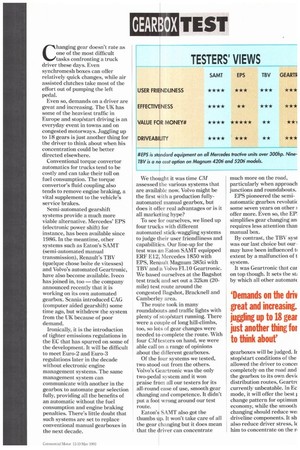C hanging gear doesn't rate as one of the most difficult
Page 41

If you've noticed an error in this article please click here to report it so we can fix it.
tasks confronting a truck driver these days. Even synchromesh boxes can offer relatively quick changes, while air assisted clutches take most of the effort out of pumping the left pedal.
Even so, demands on a driver are great and increasing. The UK has some of the heaviest traffic in Europe and stop/start driving is an everyday event in towns and on congested motorways. Juggling up to 18 gears is just another thing for the driver to think about when his concentration could be better directed elsewhere.
Conventional torque convertor automatics for trucks tend to be costly and can take their toll on fuel consumption. The torque convertor's fluid coupling also tends to remove engine braking, a vital supplement to the vehicle's service brakes.
Semi-automated gearshift systems provide a much more viable alternative. Mercedes' EPS (electronic power shift) for instance, has been available since 1986. In the meantime, other systems such as Eaton's SAMT (semi-automated manual transmission), Renault's THY (quelque chose boite de vitesses) and Volvo's automated Geartronic, have also become available. Iveco has joined in, too — the company announced recently that it is working on its own automated gearbox. Scania introduced CAG (computer aided gearshift) some time ago, but withdrew the system from the UK because of poor demand.
Ironically, it is the introduction of tighter emissions regulations in the EC that has spurred on some of the development. It will be difficult to meet Euro-2 and Euro-3 regulations later in the decade without electronic engine management systems. The same management system can communicate with another in the gearbox to automate gear selection fully, providing all the benefits of an automatic without the fuel consumption and engine braking penalties. There's little doubt that such systems are set to replace conventional manual gearboxes in the next decade. We thought it was time CM assessed the various systems that are available now Volvo might be the first with a production fullyautomated manual gearbox, but does it offer real advantages or is it all marketing hype?
To see for ourselves, we lined up four trucks with different automated stick-waggling systems to judge their user friendliness and capabilities. Our line-up for the test was an Eaton SAMT equipped ERF E12, Mercedes 1850 with EPS, Renault Magnum 385ti with TBV and a Volvo FL10 Geartronic. We based ourselves at the Bagshot test track and set out a 321un (20mile) test route around the congested Bagshot, Bracknell and Camberley area.
The route took in many roundabouts and traffic lights with plenty of stop/start running. There were a couple of long hill-climbs, too, so lots of gear changes were needed to complete the route. With four CM testers on hand, we were able call on a range of opinions about the different gearboxes. Of the four systems we tested, two stood out from the others. Volvo's Geartronic was the only two-pedal system and it won praise from all our testers for its all-round ease of use, smooth gear changing and competence. It didn't put a foot wrong around our test route.
Eaton's SAMT also got the thumbs up. It won't take care of all the gear changing but it does mean that the driver can concentrate much more on the road, particularly when approach junctions and roundabouts.
EPS pioneered the semiautomatic gearbox revolutk some seven years on other offer more. Even so, the EP! simplifies gear changing art requires less attention than manual box.
By contrast, the TBV sysi was our last choice but our may have been influenced t extent by a malfunction of t system.
It was Geartronic that car on top though. It sets the st by which all other automatt gearboxes will be judged. h stop/start conditions of the allowed the driver to concei completely on the road and the gearbox to its own devic distribution routes, Geartrt currently unbeatable. In Ec mode, it will offer the best I change pattern for optimun economy, while the smooth changing should reduce we driveline components. It sh also reduce driver stress, k him to concentrate on the r
































































































































